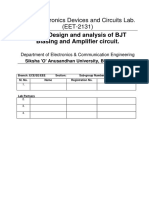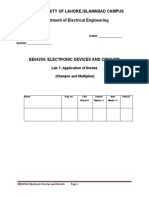Lab Report 3
Uploaded by
Yohannes AlemayehuLab Report 3
Uploaded by
Yohannes AlemayehuAddis Ababa University
Faculty of Technology
Department of Electrical and Computer Engineering
Laboratory Report
Course number: Eceg:- 2205 - Electrical Engineering Laboratory II
Experiment Number: 01
Title: Semiconductor Characteristics
Figure A: Circuit symbol for a Rectifying Diode
By: Besufekad Mekuria
Group: 1B, Subgroup 5, ID: TCR/0590/01
Date of Lab. session: November 11, 2009
Date of submission: November 18, 2009
TABLE OF CONTENTS:
AAU, FACULTY OF TECHNOLOGY, DEPARTMENT OF ELECTRICAL ENGINEERING, LABORATORY REPORT 0
Section Sub-Title Location
NO
1.1 Introduction Page Two
1.2 Objective Page Two
1.3 Preparation Page Two
1.4 Used Equipment Page Two
1.5 Components used Page Three
1.6 Theory Page Three
1.7 Procedure Page Five
1.8 Calculations Page Six
1.9 Results Page Seven
1.10 Conclusion Page Thirteen
Title
AAU, FACULTY OF TECHNOLOGY, DEPARTMENT OF ELECTRICAL ENGINEERING, LABORATORY REPORT 1
1.1 INTRODUCTION
1.2 OBJECTIVE
A. To introduce some.
B. To develop the skill of using.
1.3 PRE-LAB PREPARATION
Before the laboratory session, a laboratory manual was supplied by the Laboratory instructors. This
manual included
1.4 USED EQUIPMENT
No Description Code/Lab Reference Quantity
1 DC Power supply - 1
2 Multimeter (VOM) - 1
3 Cathode Ray oscilloscope - 1
4 Conducting Wires - 9
5 Variable Resistor - 1
6 Variable Inductors - 1
7 Variable Capacitors - 1
8 Stop watch - 1
Table 1: Electrical Equipments that were used to set up the circuit for the laboratory procedure
1.5 USED COMPONENTS
No Description Type Quantity
1 Resistor 1,000,000 Ω 1
2 Inductor 0-000001 μF 1
Table 2: Electrical Components that were used to set up the circuit for the laboratory procedure
1.6 THEORY
AAU, FACULTY OF TECHNOLOGY, DEPARTMENT OF ELECTRICAL ENGINEERING, LABORATORY REPORT 2
R
E
C
Figure 1: First Order Resistive - Capacitive Network
1.7 PROCEDURE
1 MΩ
20 V 10 pF
Figure 3: Procedural diagram for the laboratory session
1. The network for the procedure was set up according to ‘Figure 3’.
1.8 Calculations
All of the necessary calculations required
1.9 Results
After completing setting up the
Again, Graphing the measured Voltage drop as a function of time (while the capacitor is
charging) gives: (note that the graphs are drawn from the average values of the three trials
represented above).
AAU, FACULTY OF TECHNOLOGY, DEPARTMENT OF ELECTRICAL ENGINEERING, LABORATORY REPORT 3
1.10 Conclusion
Upon completion of the laboratory session, many observations were made; these observations have been
dealt with here under their own subheading.
Observations made from Analysis of first order transient Networks.
For a
Observations made about practical errors
It is a well known fact that there does not exist a circuit element that functions with a hundred percent
efficiency. Therefore slight deviations of the measured values from the calculated ones are to be expected under
any circumstances. However the possible causes for these irregularities include:
The DC voltmeter does not give rise to a potential difference with a magnitude that it is programmed to do.
This is generally due to manufacturing defects, defects from improper usage and gradual wearing off.
The leads are not of Zero Resistance; this is because of factors like: Temperature change, corrosion, etc…
The Ammeter used was an analog device; therefore readings are perceptible to be misconstrued. And also
continuous mistreatment of the device leads to incorrect readings in the future.
End of Report
AAU, FACULTY OF TECHNOLOGY, DEPARTMENT OF ELECTRICAL ENGINEERING, LABORATORY REPORT 4
You might also like
- 13 Years Test Experience With Short Circuit Withstand Capability of Large Power TransformersNo ratings yet13 Years Test Experience With Short Circuit Withstand Capability of Large Power Transformers7 pages
- Baya - Bgha - Bvga - Byba - B7wa - Maya - Mfya - MGNo ratings yetBaya - Bgha - Bvga - Byba - B7wa - Maya - Mfya - MG4 pages
- Multigas Instrument 1438382546BH-4A 英文说明书No ratings yetMultigas Instrument 1438382546BH-4A 英文说明书13 pages
- Lab Report 3 - Digital To Analog Converters100% (1)Lab Report 3 - Digital To Analog Converters7 pages
- Eee ELECTRICAL MACHINES-I DC LAB MANUAL 10122019 PDFNo ratings yetEee ELECTRICAL MACHINES-I DC LAB MANUAL 10122019 PDF68 pages
- Laboratory Manual Power Systems Laboratory (R18A0287) Iv B.Tech I - Sem (Eee)No ratings yetLaboratory Manual Power Systems Laboratory (R18A0287) Iv B.Tech I - Sem (Eee)54 pages
- Electric Circuits: Lab Manual Experiment No 8No ratings yetElectric Circuits: Lab Manual Experiment No 86 pages
- Load Test On Single Phase Transformer: Shubham Sharma: RA2111003010611: 28.10.21No ratings yetLoad Test On Single Phase Transformer: Shubham Sharma: RA2111003010611: 28.10.2111 pages
- Dev Bhoomi Institute Chakrata Road, Navgaoun Manduwala, UttarakhandNo ratings yetDev Bhoomi Institute Chakrata Road, Navgaoun Manduwala, Uttarakhand32 pages
- Basic Electrical - Electronics Lab Manual PDFNo ratings yetBasic Electrical - Electronics Lab Manual PDF48 pages
- Ael1037b-I Power Electronics Trainer v1.2014No ratings yetAel1037b-I Power Electronics Trainer v1.20142 pages
- American International University-Bangladesh: Title: Ramp Control of A Single Phase Half Converter AbstractNo ratings yetAmerican International University-Bangladesh: Title: Ramp Control of A Single Phase Half Converter Abstract3 pages
- Lab Manual: EGCI 232 Engineering ElectronicsNo ratings yetLab Manual: EGCI 232 Engineering Electronics26 pages
- Basic Electrical Engineering Lab ManualNo ratings yetBasic Electrical Engineering Lab Manual66 pages
- Lab 4: Design and Analysis of BJT Biasing and Amplifier CircuitNo ratings yetLab 4: Design and Analysis of BJT Biasing and Amplifier Circuit7 pages
- Analog Electronics Laboratory Manual 10ESL37No ratings yetAnalog Electronics Laboratory Manual 10ESL3758 pages
- Electronics Training Equipment 1-Electronics Trainer SS1101C Linear Circuit Lab Teaching EquipmentNo ratings yetElectronics Training Equipment 1-Electronics Trainer SS1101C Linear Circuit Lab Teaching Equipment103 pages
- Instrumentation_and_Measurements_Lab_ManNo ratings yetInstrumentation_and_Measurements_Lab_Man45 pages
- Department of Electrical Engineering: Nukhba Amir Shameen Mazhar Maryam ShafeeqNo ratings yetDepartment of Electrical Engineering: Nukhba Amir Shameen Mazhar Maryam Shafeeq14 pages
- Grinblat 2021 Nonlinear Dielectric Nanoantennas and Metasurfaces Frequency Conversion and Wavefront ControlNo ratings yetGrinblat 2021 Nonlinear Dielectric Nanoantennas and Metasurfaces Frequency Conversion and Wavefront Control27 pages
- Advanced Science - 2022 - Reineke Matsudo - Efficient Frequency Conversion With Geometric Phase Control in OpticalNo ratings yetAdvanced Science - 2022 - Reineke Matsudo - Efficient Frequency Conversion With Geometric Phase Control in Optical12 pages
- DSA - List of Experiments From Virtual Lab Portal - Additional PracticeNo ratings yetDSA - List of Experiments From Virtual Lab Portal - Additional Practice6 pages
- Test Frequency and Acceptance Criteria: Subgrade/Shoulder/Median75% (4)Test Frequency and Acceptance Criteria: Subgrade/Shoulder/Median6 pages
- Electrical Wiring Installation Guide MPDNo ratings yetElectrical Wiring Installation Guide MPD10 pages
- MDE-4868F Fuel Point PLUS Vehicle Installation - Anillos y DatapassNo ratings yetMDE-4868F Fuel Point PLUS Vehicle Installation - Anillos y Datapass132 pages
- 12-CDP-2017-2020-Appendix-01 Problem Solution Matrix100% (1)12-CDP-2017-2020-Appendix-01 Problem Solution Matrix32 pages
- 34 WaterScienceandTechnology2013 duPisaniMengeNo ratings yet34 WaterScienceandTechnology2013 duPisaniMenge15 pages
- MAN0017910 GenexusIntegratedSequencer UGNo ratings yetMAN0017910 GenexusIntegratedSequencer UG230 pages
- Classification and Identification of Mosquitoes of New MexicoNo ratings yetClassification and Identification of Mosquitoes of New Mexico7 pages
- 13 Years Test Experience With Short Circuit Withstand Capability of Large Power Transformers13 Years Test Experience With Short Circuit Withstand Capability of Large Power Transformers
- Baya - Bgha - Bvga - Byba - B7wa - Maya - Mfya - MGBaya - Bgha - Bvga - Byba - B7wa - Maya - Mfya - MG
- Eee ELECTRICAL MACHINES-I DC LAB MANUAL 10122019 PDFEee ELECTRICAL MACHINES-I DC LAB MANUAL 10122019 PDF
- Laboratory Manual Power Systems Laboratory (R18A0287) Iv B.Tech I - Sem (Eee)Laboratory Manual Power Systems Laboratory (R18A0287) Iv B.Tech I - Sem (Eee)
- Load Test On Single Phase Transformer: Shubham Sharma: RA2111003010611: 28.10.21Load Test On Single Phase Transformer: Shubham Sharma: RA2111003010611: 28.10.21
- Dev Bhoomi Institute Chakrata Road, Navgaoun Manduwala, UttarakhandDev Bhoomi Institute Chakrata Road, Navgaoun Manduwala, Uttarakhand
- American International University-Bangladesh: Title: Ramp Control of A Single Phase Half Converter AbstractAmerican International University-Bangladesh: Title: Ramp Control of A Single Phase Half Converter Abstract
- Lab 4: Design and Analysis of BJT Biasing and Amplifier CircuitLab 4: Design and Analysis of BJT Biasing and Amplifier Circuit
- Electronics Training Equipment 1-Electronics Trainer SS1101C Linear Circuit Lab Teaching EquipmentElectronics Training Equipment 1-Electronics Trainer SS1101C Linear Circuit Lab Teaching Equipment
- Department of Electrical Engineering: Nukhba Amir Shameen Mazhar Maryam ShafeeqDepartment of Electrical Engineering: Nukhba Amir Shameen Mazhar Maryam Shafeeq
- Grinblat 2021 Nonlinear Dielectric Nanoantennas and Metasurfaces Frequency Conversion and Wavefront ControlGrinblat 2021 Nonlinear Dielectric Nanoantennas and Metasurfaces Frequency Conversion and Wavefront Control
- Advanced Science - 2022 - Reineke Matsudo - Efficient Frequency Conversion With Geometric Phase Control in OpticalAdvanced Science - 2022 - Reineke Matsudo - Efficient Frequency Conversion With Geometric Phase Control in Optical
- DSA - List of Experiments From Virtual Lab Portal - Additional PracticeDSA - List of Experiments From Virtual Lab Portal - Additional Practice
- Test Frequency and Acceptance Criteria: Subgrade/Shoulder/MedianTest Frequency and Acceptance Criteria: Subgrade/Shoulder/Median
- MDE-4868F Fuel Point PLUS Vehicle Installation - Anillos y DatapassMDE-4868F Fuel Point PLUS Vehicle Installation - Anillos y Datapass
- 12-CDP-2017-2020-Appendix-01 Problem Solution Matrix12-CDP-2017-2020-Appendix-01 Problem Solution Matrix
- Classification and Identification of Mosquitoes of New MexicoClassification and Identification of Mosquitoes of New Mexico






























































































